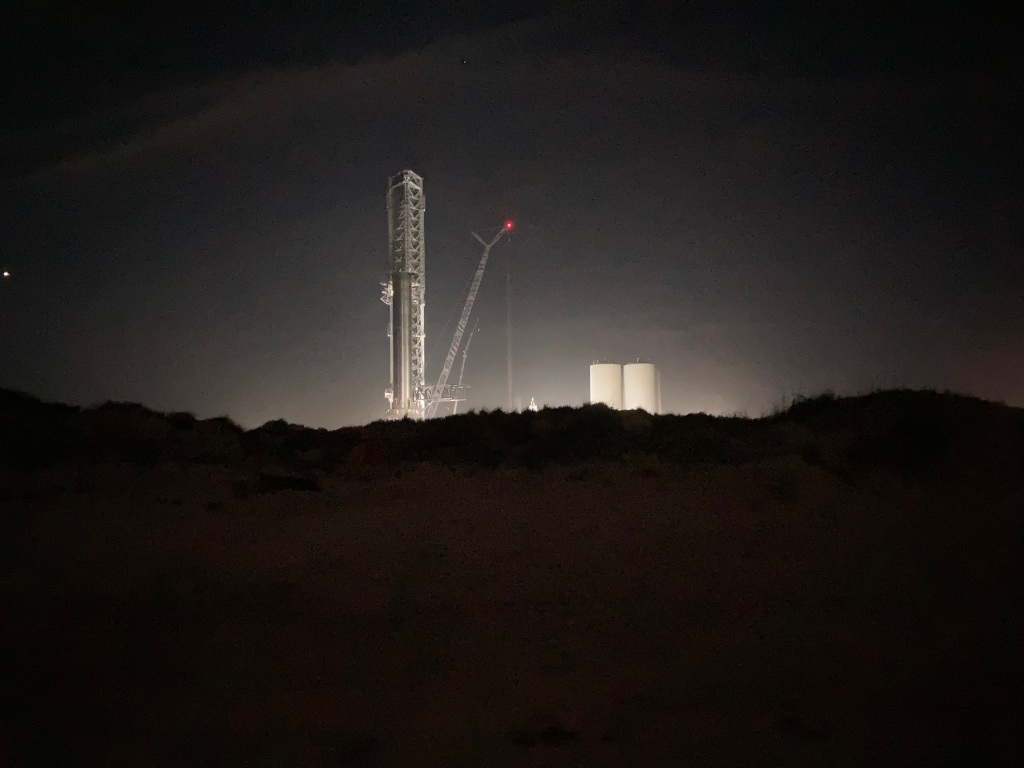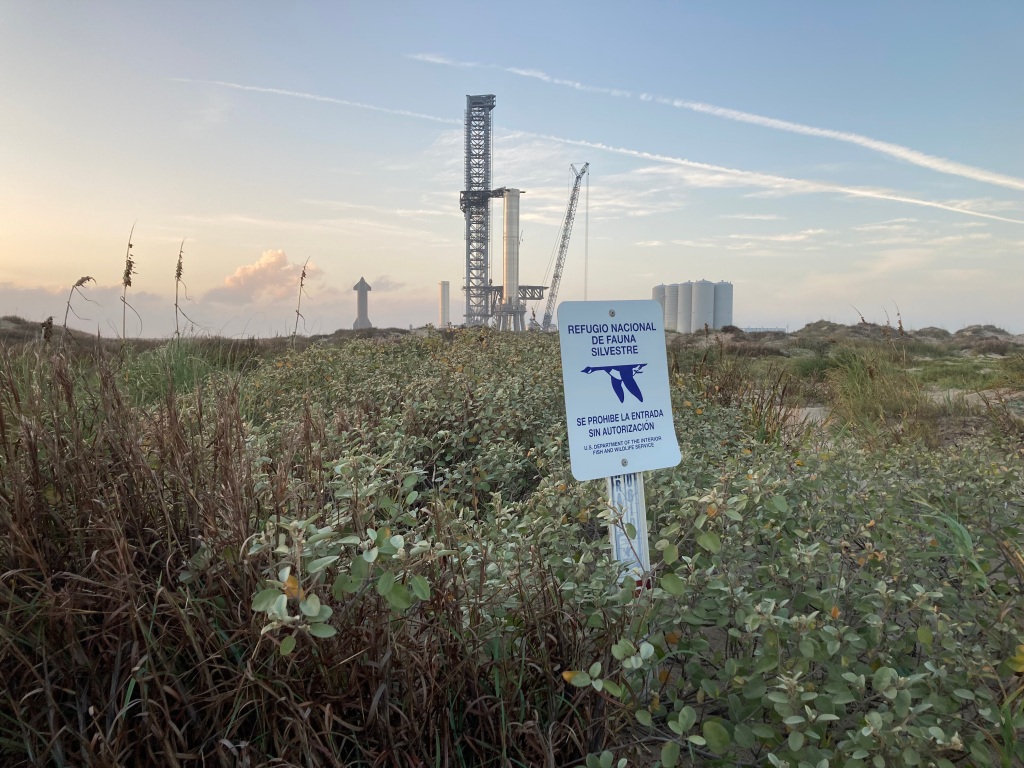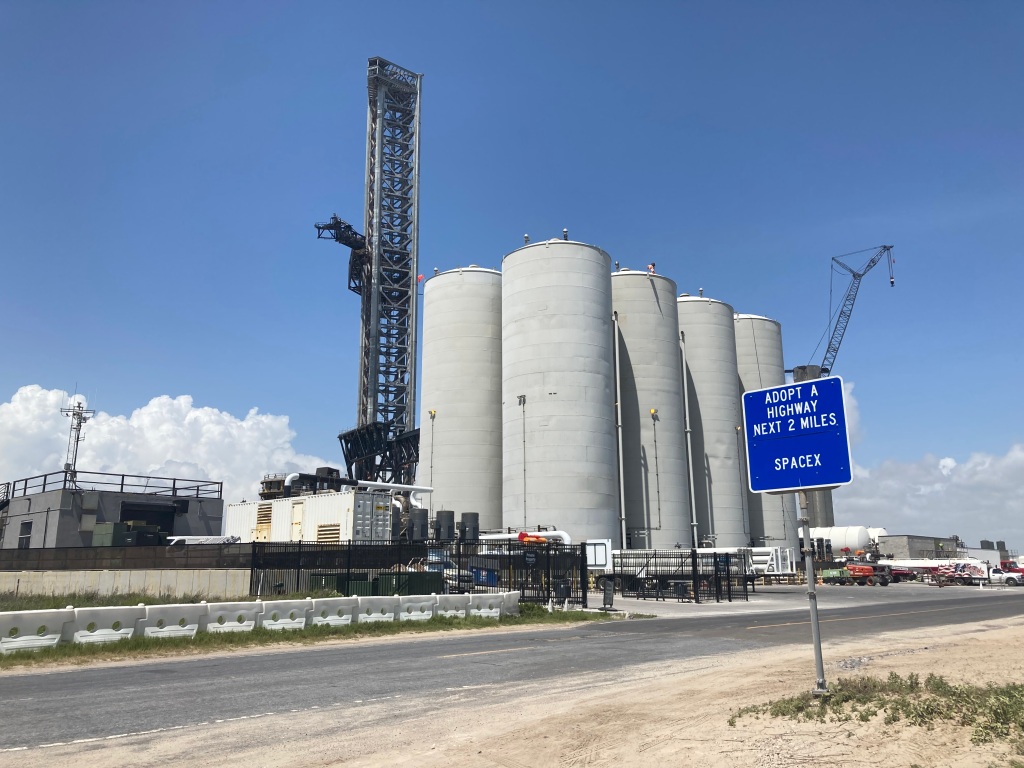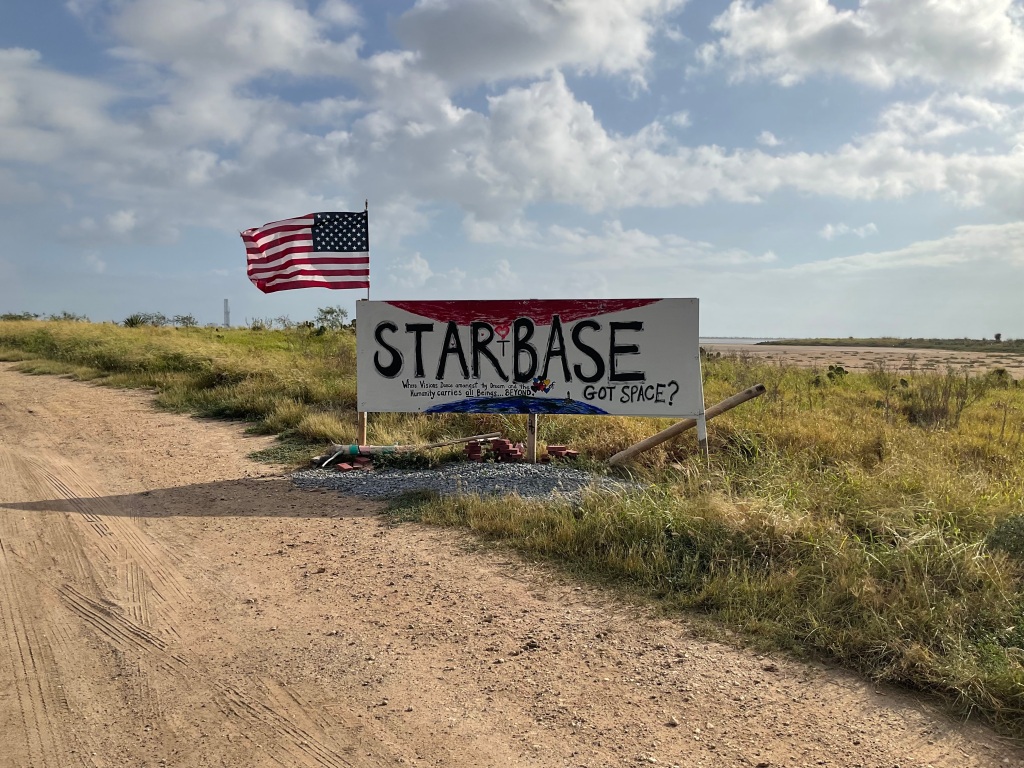By Robert Kopack, University of South Carolina § I was startled awake by a faint voice announcing something […]
By Robert Kopack, University of South Carolina §
I was startled awake by a faint voice announcing something across the humid, coastal air. Maybe it was a shift change? In the tidal flats, workers were at it through the night with torches sparking like fireflies. It was a strange, nocturnal Texas scene, and all very “Bradburyesque,” with lanky cranes subbing in for the legs of busy mechanical spiders. Bright spotlights illuminating the “rocket stack” shone through my orange tent, which I’d staked deep into the sand as the wind tore at it. I fell back asleep to the smell of acrid hydrocarbons and some blend of hydraulic chemicals and solvents. The next morning at Boca Chica Beach, a steady stream of pilgrims began clamoring high onto the dunes to catch a glimpse of what many know today as “Star Base.”
 Rocket assembly at night. Boca Chica Beach, Texas. Photo by author 2021.
Rocket assembly at night. Boca Chica Beach, Texas. Photo by author 2021.I was not among the crowds of spectators, some wearing “colonize Mars” t-shirts, on South Padre Island or Port Isabelle roughly two years later, when the world’s largest ever rocket exploded about 25 miles above the Gulf of Mexico. “Excitement guaranteed,” assured management of Space Exploration Technologies Inc. (SpaceX) prior to the launch. “Learned a lot,” noted CEO Elon Musk, “for the next test launch in a few months” (Chang 2023).
Intriguingly, while the 400-foot rocket exploded, it turns out that for many, it was nothing to lament. The incident was applauded. As per SpaceX quality systems coordinator Kate Tice, just clearing the launch pad was “a win,” while NASA Administrator Bill Nelson noted that “from great risk, comes great reward…looking forward to all that SpaceX learns” (Musunaga and Hussain 2023). One thing learned is undoubtedly that the company will have to rebuild the launch pad, from which pulverized concrete reportedly travelled six and half miles away, when it too was destroyed (Davilla 2023).
In 2014, SpaceX began construction on what has since been named by the company, Star Base. Straddled by Brazos Island and Boca Chica State Park, the construction and expansion of the site has created divergent interpretations regarding what this landscape actually is. Feelings about the launch and assembly facilities at Texas’ most southern beach at the end of State Highway 4, vary widely from an outright techno-hero-entrepreneur worship of Elon Musk to pride for Texas’ continuing place on the map of U.S. space history. For others, feelings are far more cautious and defensive. There is a growing cultural and legal challenge waged by environmental groups and activist communities like Save the Rio Grande Valley (Save RGV), Another Gulf is Possible, and the Surf Rider Foundation. For them and others, the imperative is to insert the local coastal geography known for its lomas (fog watered vegetation), migratory birds, turtles, wetlands, wildflowers, and dunes into what has become a contest over the meaning of this landscape. Add the voices of indigenous groups from South Texas into the conversation, and the matter only grows in complexity.
 Protected wildlands at the crossroads. Boca Chica Beach, Texas. Photo by author 2021.
Protected wildlands at the crossroads. Boca Chica Beach, Texas. Photo by author 2021.“Outer space,” it was recently written, “should be of pressing concern within contemporary human geography given the increasing prominence of outer space within culture and politics,” (Dunnett et. al. 2019: 315). If pressed, the question can come down to a matter of landscape, long a seminal word for geographers. It remains salient as an organizing concept when considering the world as a visible configuration of human activities over time. To think through landscape is to pause and reflect on process, what we see and don’t see, and take the time to consider that perception requires a certain amount of conditioning. After all, what is considered beautiful; ordered; disordered; sacred; empty; a wasteland? These are value judgements. The state of landscape studies at the end of the 20th century, so wrote Don Mitchell (2001: 270), has been charged by the realities of a “deeply unjust” world. No doubt we’re still living through that moment. Whether it’s an urban or rural context, matters of private property, enclosure, displacement, or gentrification are integral aspects to landscape studies because they provide a window onto social conditions in the world. Power relations structure the landscape, providing historical contours and definition, and undoubtedly cementing structures of inequality. In an unfortunately dispassionate sense, landscapes are where tradeoffs are made and where dominant ways of seeing win out over others; whether it’s a matter of commercial real estate over affordable housing, or if it’s a matter of science and technology over open space and wild-lands.
 SpaceX property, infrastructure, and stewardship of the coast. Boca Chica Beach, Texas. Photo by author 2021.
SpaceX property, infrastructure, and stewardship of the coast. Boca Chica Beach, Texas. Photo by author 2021.My first trip to Boca Chica was in the summer of 2021. An interest in the social and environmental histories of military industrial rocket facilities that propelled my research at Kazakhstan’s Baikonur Cosmodrome, had me following the ticker tape of news threads about what SpaceX has been up to in Texas. In this current moment, the deep pockets of NASA are urging our gazes to the Moon and to Mars, and together with SpaceX, they applaud colossal explosions over the South Texas coast in the name of learning. This offers an opportunity to reflect upon the contentious nature of earth landscapes that serve as gateways to the cosmos.
South Texas and the Cosmos: One Vision of Landscape
Texas has a long symbolic and material association with U.S. space endeavors, and this has contributed in unique ways to political, economic, and even cultural identities within the state. The Johnson Space Center (aka “space city”) in Houston has been crucial to piloted orbital and lunar missions since 1967. The state’s industrial base has continued to grow beyond the Cold War, through government contracts and subsidies, such that nearly every key aerospace manufacturer in the world, from Boeing, to General Electric, to Lockheed Martin has “major operations in Texas” (Office of the Texas Governor 2021: 1).
SpaceX and Boca Chica Beach are a new jewel in the state’s landscape of high-tech industrial assets. Since construction began, a new vision for the Texas-Mexico coastal border region has been widely promoted by area politicians and boosters. Boca Chica: the “gateway to Mars!” reads a common print refrain (Papallardo 2022). Nearby Brownsville recently declared a new era for itself as a “Newspace City,” echoing the message amongst many state leaders for the economic tidal wave that SpaceX promised to draw to one of the poorest areas in the country in the form of industry jobs. The state’s governor, Greg Abbot, has been among the billionaire Musk’s most visible, public advocates and one dedicated to “working with him [Musk] very closely, every step of the way in Boca Chica for the future of SpaceX” (Taylor 2022).
In the current market of privatized space firms in the United States, SpaceX is the clear leader. As a contractor, they’ve worked closely with NASA to provide piloted launch services and supply missions to the International Space Station from Cape Canaveral, Florida. This collaboration has been enormously impactful to the U.S. national space program as it began pivoting away from the Russian technology and launch sites they’d been using for nearly two decades (Kopack 2021). Star Base is not precisely like Cape Canaveral, however. It is a private research, assembly, and test site to develop the rocket technology for lunar missions and beyond, which NASA could then procure. As such, Texas is ever more within a national landscape of strategic U.S. industrial installations. For nearly ten years now, this has required extensive alterations to the environment in the form of poured concrete, hydrological engineering, and road construction. Here, where the Rio Grande carves a meandering border between the U.S. and Mexico, towering rockets, powerlines, and bloated fuel storage tanks have dramatically impacted what the area looks like.
That isn’t to say that there haven’t been any legal barriers to the wholesale industrialization of Boca Chica from a regulatory perspective. A 2021 Federal Aviation Administration hold was enacted over site licensing, land use plans, and under-researched environmental impacts. The Army Corps of Engineers has also taken a turn and blocked a 2021 site expansion proposal to the facility. Nevertheless, the FAA gave the green light for the recent test launch of “Starship,” which is the frontrunner of the firm’s line of heavy lift, lunar and interplanetary rockets. Cynically, one could say that the loss of it, due to a “rapid, unscheduled disassembly” was insignificant according to the CEO Musk’s own vision of landscape: “we’ve got a lot of land with no one around, so if it blows up [any rocket that is] it’s cool” (Koren 2020). Recent work in anthropology, such as Simmons’ (2019) concept of the “expanse,” offers a perspective onto the political discourses which work through forms of settler colonialism to create new visions for landscape.
All signs are pointing to this remote part of the U.S. becoming the new epicenter for space exploration underwritten by what has been cheekily put as the firm’s “explode and learn” model of developing technology (Victor and Chang 2023). In this process of envisioning and building out Boca Chica as a test area, one perspective is becoming quite clear. Boca Chica is land that provides a means. Throughout the United States a similar economic and technological development model is becoming common. There are already thirteen states with commercial launch sites and there’s growing enthusiasm for how they can stimulate local economies. Recently in Michigan, a meeting hosted by the state’s Aerospace Manufacturers Association featured a headlining brochure titled, “Welcome to the Space Gold Rush” (Rompf 2022).
As Texas legislators count the roughly 11 billion dollars added to the state’s coffers because of the growing “space economy,” no doubt those from Michigan and elsewhere are paying attention (Perryman 2022). Such a mindset, however, produces different geographic imaginaries, ones that redraw locales into a larger constellation of industrial sites which can attract capital. Part of the issue, for those who oppose, are the environmental costs of building and operating launch facilities—not to mention the regimes of governance and enclosure that have been put into place for that purpose.
An Alternate Vision of Landscape
It was windy, and high noon in early July. The sands of Boca Chica Beach were blowing across that terminus of State Highway 4 where it meets the magically blue Gulf of Mexico. The tall dunes spilled onto the dark asphalt. “We’re lucky to be here today,” said Mary Angela, “the courts are allowing Musk to close the road and the beach whenever he asks.” I struggled to hear her and two others from Save RGV as a steady stream of cars crept towards us to park. “They’ve abstracted all of this…” she said, motioning her hand across the horizon where a towering rocket poked out from behind the dunes. “It has all changed so fast.” As Mary Angela spoke, people exited their cars and climbed the trails through the sand to catch a view and take selfies.
As state business and political leaders have flocked to the economic potentials that SpaceX has promised to bring to one of the country’s poorest counties, they have helped to rearticulate how the wider public understands this remote Texas coastline. Assuredly, more people know about it now than before. It’s become a destination for space enthusiasts. Part of what’s been going on is a battle over meaning—over the value of protected coastal wildlands weighed against space exploration. Words spoken by Elon Musk in the past about the emptiness of the landscape have made space operations seemingly benign. But what the rhetoric supporting space dreams is missing, is the political and environmental dispossessions that is taking place on the ground.
Operations at Star Base are made possible by increasingly tight security and attendant safety measures. Authorized by the court system of Cameron County, the company can ask for road and beach closures. According to Jim Chapman a member of Save RGV, SpaceX says “jump” and the courts say, “how high?” Road and beach closures, while logical for public safety during rocket testing events, has changed how people use the area. It’s public land, yet it is subject to enclosure as would private property. The frequency of beach closures has been increasing to sometimes weekly intervals. Beach closures can and often are cancelled, however, a fact which further complicates any plans that the public might have regarding their now sporadic access. Murals dedicated to Elon Musk in Brownsville and other tributes to SpaceX found along Highway 4 omit how politically integrated the company is with county and state politics.
The question of the environment is conspicuously absent from the glowing prose about space science and technology. What also slips through the cracks here, particularly in terms of governance, is precisely how state-guaranteed access to public land in Texas is purportedly assured by the state’s constitutional law. No doubt there is money to be made from creating what environmental groups like Save RGV call a “false picture of planetary inclusion when it’s really all just about money.” A space themed restaurant in nearby Port Isabel called Hopper Haus Barbase is a novel example of how local entrepreneurs are capitalizing on a particularly myopic vision. Wednesday drink specials there feature a green cocktail called the “Elondo,” so named after Musk. In addition, Hopper Haus features draft beers from Starbase Brewing in Austin (“the official brewery of Mars”) and hosts music events with the brewing company’s underwriting.
For tourists looking to stay the night near Star Base, “Rocket Ranch” offers the ultimate in glamping for SpaceX fans. Buried among scrubby pines and sable palm forest, the private site broadcasts live streaming video on several screens from launch and assembly sites at Star Base. In their main house, featuring small-batch coffee and organic milk, the proprietors have started a scrap metal installation on the wall, made from the debris of failed launches they’ve collected from the dunes. “It’s not debris,” I was quickly corrected during my own stay, “but memorabilia—a way for our guests to connect with the site and the vision. Getting to Mars is a really important step.”
Landscapes as Sites of Exchange
When I first drove out to Boca Chica in 2021, I pulled over to take some photos and to read a hand-painted billboard that said: “Starbase: Where visions dance amongst thy dream and the love of humanity carries all beings…beyond” GOT SPACE??” A caravan of construction crews in various makes and models of trucks, and more Teslas than I’ve ever seen in one place, went whizzing passed me towards assembly and launch sites down the road. Huge spools of cable rested on the shoulder as men in boom trucks worked to string it up.
 Roadside homage to SpaceX. Boca Chica Beach, Texas. Photo by author 2021.
Roadside homage to SpaceX. Boca Chica Beach, Texas. Photo by author 2021.I would be remiss to omit the evident sincerity among many who are proud of U.S. space technology. There is something quite important to it all. Space exploration is inseparable from the cultural mythologies that help to frame out U.S. history. Competition with the Soviets, the tragic deaths of astronauts, triumphant missions, all of these things help to impart, for many, a sense of national character, a shared vision, a common path. The challenge, however, is to ask the difficult question: what is being exchanged to do all this space stuff? How are military industrial priorities, of which space technologies can be defined, actually realized? What are the costs to the natural world?
From an environmental standpoint, the recent explosion of the Starship is another wakeup call. Particulate matter fell across Port Isabel and South Padre Island, following the event, which initiated an “Anomaly Response Plan,” part of a contractual agreement between SpaceX and the Texas Parks and Wildlife Department (De La Rosa 2023). The details are outlined in a 5-page memoranda covering land use and company responsibility, and all but assure that things such as “fire suppression, reconnaissance, rocket debris retrieval, post-response site restoration, and impact mitigation” that have occurred, are likely to be needed again (FAA 2022). Across SpaceX launch sites elsewhere, such as Cape Canaveral, Florida, for example, the regulations that govern public safety are rooted in things as fickle as the direction of the wind. In 2019, a test firing of the company’s Crew Dragon capsule went awry, sending a dangerous, reddish-orange plume of hydrazine fuel (used for in-orbit propulsion) toward surfers at Cocoa Beach rather than out over the Atlantic Ocean (Waymer 2019). Is it time that we consider the costs of “colonizing” Mars with the growing realities that landscapes on Earth are being colonized in order to do so?
Work Cited
Chang, Kenneth. 2023. “SpaceX’s Starship ‘Learning Experience Ends in Explosion.” The New York Times. 20 April. https://www.nytimes.com/2023/04/20/science/spacex-launch-explosion-elon-musk.html. Last accessed 3 August 2023.
Davilla, Gaige. 2023. “SpaceX is Grounded After Rocket Explosion Caused Extensive Environmental Damage.” National Public Radio. 27 April. https://www.npr.org/2023/04/26/1172290009/spacex-is-grounded-after-rocket-explosion-caused-extensive-environmental-damage#:~:text=The%20Federal%20Aviation%20Administration%20has,area%20around%20the%20launch%20site. Last accessed 03 August 2023.
De La Rosa, Pablo. 2023. “Port Isabel Reports ‘Raining Particulates’ After SpaceX Rocket Explodes Over the RioGrande Valley.” Texas Public Radio. 22 April. https://www.tpr.org/technology-entrepreneurship/2023-04-20/port-isabel-particulates-spacex-explosion-rio-grande-valley. Last accessed 3 August 2023.
Dunnet, Oliver et. al. 2017. “Geographies of Outer Space: Progress and New Opportunities.” Progress in Human Geography. 43(2): 314-336.
Federal Aviation Administration. 2022. “Memoranda of Agreement Between SpaceX and TPWD.” https://www.faa.gov/sites/faa.gov/files/2022-06/AppendixK_MOA_BetweenTPWDandSpaceX.pdf. Last accessed 3 August 2023
Kopack, Robert. 2021. “Baikonur 2.0: ‘Inland-offshore’ Space Economies in Post-Soviet Kazakhstan.” Culture, Theory, and Critique. 62(1-2):96-112.
Koren, Marina. 2020. “Why SpaceX Wants a Tiny Texas Neighborhood So Badly.” The Atlantic. 11 February. https://www.theatlantic.com/science/archive/2020/02/space-x-texas-village-boca-chica/606382/. Last accessed 03 August 2023.
Mitchell, Don. 2001. “The Lure of the Local: Landscape Studies at the End of a Troubled Century.” Progress in Human Geography. 25(2): 269-281.
Musunaga, Samantha and Suhauna Hussain. 2023. “Massive Starship Rocket Explodes After Launch—SpaceX Calls it a ‘Win.’” The Los Angeles Times. 20 April. https://www.latimes.com/business/story/2023-04-20/spacexs-massive-starship-rocket-clears-the-launch-pad-but-explodes. Last accessed 3 August 2023.
Office of the Texas Governor. 2021. “Texas Aerospace, Aviation, and Defense Industry.” https://gov.texas.gov/uploads/files/business/TexasAerospaceReport.pdf. Last accessed 3 August 2023.
Papallardo, Joe. 2022. “SpaceX’s Starship Gets Closer to Launch but the Future of its Texas Star Base is in Doubt.” National Geographic. 14 June. https://www.nationalgeographic.com/science/article/spacex-starship-gets-closer-to-launchbut-the-future-of-its-texas-starbase-is-in-doubt. Last accessed 3 August 2023.
Perryman, M. Ray. 2022. “Perryman: Blast off.” Rio Grande Guardian. 25 February. https://riograndeguardian.com/perryman-blast-off/. Last accessed 3 August 2023.
Rompf, David. 2022. “The Plan to Make Michigan The Next Space State.” The New Yorker. 24 April. https://www.newyorker.com/news/us-journal/the-plan-to-make-michigan-the-next-space-state. Last accessed 3 August 2023.
Simmons, Kristin. 2019. “Expanse.” Journal for the Anthropology of North America. 22(2): 103-105.
Taylor, Steve. 2022. “Abbott: I Will Do All I Can to Keep SpaceX at Boca Chica.” Rio Grande Guardian.” 12 April. https://riograndeguardian.com/abbott-i-will-do-all-i-can-to-keep-spacex-at-boca-chica/#:~:text=%E2%80%9CWhat%20I%20am%20going%20to,to%20launch%20from%20Boca%20Chica. Last accessed 3 August 2023.
Victor, Daniel and Kenneth Chang. 2023. “Starship Exploded, But SpaceX Had Reason to Pop Champagne Anyway.” The New York Times. 20 April. https://www.nytimes.com/2023/04/20/science/rapid-unscheduled-disassembly-starship-rocket.html#:~:text=SpaceX%20Starship%20Launch-,Starship%20Exploded%2C%20but%20SpaceX%20Had%20Reason%20to%20Pop%20Champagne%20Anyway,as%2Dyou%2Dlearn%20approach. Last accessed 3 August 2023.
Waymer, Jim. 2019. “SpaceX’s Crew Dragon Fire Sent Hazardous Chemical Compounds into the Environment.” Florida Today. 25 April. https://www.floridatoday.com/story/news/local/environment/2019/04/25/spacexs-crew-dragon-incident-sent-hazardous-chemicals-into-environment/3548180002/#. Last accessed 3 August 2023.
Dr. Robert Kopack received his PhD from the University of Toronto and now holds an instructor position in the Department of Geography at the University of South Carolina. His research looks broadly at military-industrialization as a landscape forming processes with deeply entrenched social and environmental histories. Particular themes of interest are defense site closure and remediation projects related to rocket and missile ranges. His specific areas of interest are the former Soviet Union and Kazakhstan specifically, as well as the United States. His current research looks at the political-economy, environmental governance, and public policy underwriting commercial launch and test facilities.












